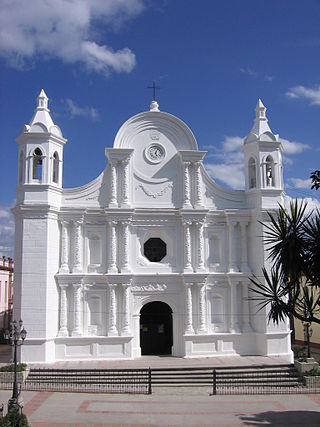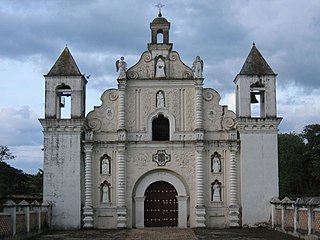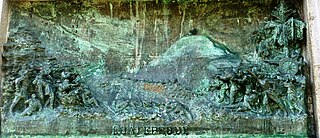
José Francisco Morazán Quesada was a liberal Central American politician and general who served as president of the Federal Republic of Central America from 1830 to 1839. Before he was president of Central America he was the head of state of Honduras. He rose to prominence at the Battle of La Trinidad on November 11, 1827. Morazán then dominated the political and military scene of Central America until his execution in 1842.

Copán is one of the departments in the western part of Honduras. The departmental capital is the town of Santa Rosa de Copán. The department is well known for its tobacco and fine cigars.

José Rafael Carrera y Turcios was the president of Guatemala from 1844 to 1848 and from 1851 until his death in 1865, after being appointed President for life in 1854. During his military career and presidency, new nations in Central America were facing numerous problems: William Walker's invasions, liberal attempts to overthrow the Catholic Church and aristocrats' power, the Civil War in the United States, Mayan uprising in the east, Belize boundary dispute with the United Kingdom, and the wars in Mexico under Benito Juárez. This led to a rise of caudillos, a term that refers to charismatic populist leaders among the indigenous people.

Gracias is a small Honduran town/municipality that was founded in 1536, and is the capital of Lempira Department.

Juan Nepomuceno Fernández Lindo y Zelaya, generally known as Juan Lindo, was a conservative Central American politician, provisional president of the Republic of El Salvador from 1841 to 1842, and President of the Republic of Honduras from 1847 to 1852.

José Trinidad Cabañas Fiallos was a liberal Honduran military general and politician who served as President of Honduras on two separate occasions: From 1 March to 6 July 1852. And 31 December 1853 to 6 June 1855. His role in Honduran history began during the First Central American Civil War. He became a Central America hero, when he attempted to reunite Central America, during Francisco Morazán's tenure and after the unionist's death.

Doroteo Vasconcelos Vides y Ladrón de Guevara was President of El Salvador 7 February 1848 - 1 February 1850 and 4 February 1850 – 1 March 1851. Vasconcelos was close friend of Honduran general Francisco Morazán. He tried to invade Guatemala and defeat general Rafael Carrera on 2 February 1851 but he was defeated. After defeat, he retired from public life.

Mataquescuintla is a town and municipality in the Jalapa department of south-east Guatemala. It covers 262 square kilometres (101 sq mi).

José Dionisio de la Trinidad de Herrera y Díaz del Valle was a Liberal Honduran politician, head of state of Honduras from 1824 to 1827 and head of state of Nicaragua from 1830 to 1833. During his terms, Honduras and Nicaragua were states within the Federal Republic of Central America. Herrera was an uncle of the Liberal Central American general Francisco Morazán.

Father José Trinidad Reyes y Sevilla was a Honduran priest who founded the National Autonomous University of Honduras, formerly called "La Sociedad del Genio emprendedor y del buen gusto". He advocated against poverty by assisting the poor and supporting their right to education on matters of faith, culture, and science.
The Battle of La Arada was fought on 2 February 1851 near the town of Chiquimula in Guatemala, between the forces of Guatemala and an Allied army from Honduras and El Salvador. As the most serious threat to Guatemala's liberty and sovereignty as a republic, it was the most important military victory in the country's history as an independent state.

Ramón Rosa Soto was a lawyer, journalist, politician and liberal writer of the second half of the nineteenth century. He was the ideologue of educational changes of Liberal Reform in Guatemala and then in Honduras. He served as Principal Minister during the rule of his cousin, Dr. Marco Aurelio Soto and was associated with Soto's mining investments.

Vicente Cerna y Cerna was president of Guatemala from 24 May 1865 to 29 June 1871. Loyal friend and comrade of Rafael Carrera, was appointed army's Field Marshal after Carraera's victory against Salvadorian leader Gerardo Barrios in 1863. He was appointed Carrera's successor after the caudillo's death in 1865 even though Guatemalan leaders would have preferred Field Marshal José Víctor Zavala.

The First Central American Civil War was a civil political and military conflict within the Federal Republic of Central America which lasted from 1827 until 1829. The civil war was fought between Liberal and Conservative lines with Francisco Morazán leading the Liberals and Manuel José Arce, a former Liberal, leading the Conservatives.

The Battle of Coatepeque was fought between the forces of El Salvador and Guatemala from 22 to 24 February 1863.

The Battle of La Trinidad occurred in Honduras in 1827, during the revolutionary period in Central America between 1811 and 1844.

Malespín's War was a Salvadoran and Honduran invasion of Nicaragua caused by the election of liberal democrat Manuel Pérez at the time of Central American turmoil dictated by Rafael Carrera's conservative dictatorship in Guatemala.

The Second Central American Civil War or the Second Central American Federal War was a military conflict in Central America between 1838 and 1840.
The Battle of Los Llanos de Santa Rosa was fought on February 22 of 1852 between the coalition of the Guatemalan and Salvadoran armies and the Honduran army under the command of José Trinidad Cabañas.
The Honduran-Guatemalan War (1853–1855) was a military conflict between the republics of Honduras and Guatemala sparked by the election of José Trinidad Cabañas, which opposed to the conservative ideologies of the guatemalan president, Rafael Carrera.
















